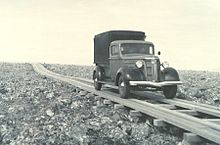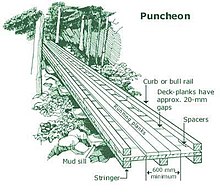User:LaurentianShield/PlankRoadDraft
A plank road was a type of road construction very popular for a brief period in the 19th century, especially in North America. Loosely speaking, plank roads include a variety of roads constructed with boards or planks as pavement, but as a major type of road construction, they were a phenomenon limited to that time period. Plank roads were some times known as the "farmers' railroad" because they offered an alternative to the perceived monopolistic practices of the railroads. Plank roads in North America (United States and Canada) were generally constructed by companies incorporated by government charter, and received a return on their investment by charging tolls.
A plank road is a dirt path or road covered with a series of planks, similar to the wooden sidewalks one would see in a Western movie. Plank roads were very popular in Ontario, the U.S. Northeast and U.S. Midwest in the first half of the 19th century. They were often built by turnpike companies.

Plank road boom[edit]
In the late 1840s plank roads led to an investment boom and subsequent bust. The first plank road in the US was built in North Syracuse, New York in order to transport salt and other goods;[1] it appears[weasel words] to have copied earlier roads in Canada that copied Russian ones.[2] The plank road boom was like many early technologies, promising to transform the way people lived and worked, and led to permissive changes in legislation seeking to spur development, speculative investment by private individuals, etc. Ultimately the technology failed to live up to its promise and millions of dollars in investments evaporated almost overnight.[citation needed]
Three plank roads, the Hackensack, the Paterson and the Newark, were major arteries in northern New Jersey, which connected the Hudson River waterfront to the cities after which they are named on the other side of the Hackensack Meadows.


Kingston Road (Toronto) (Governor's Road), Danforth Avenue in Toronto were plank roads built by the Don and Danforth Plank Road Company in the late 18th and early 19th Centuries. Highway 2 (Ontario) from Toronto eastwards was once plank roads in the 19th Century and later paved.
Plank roads in Australia[edit]
In Perth, Western Australia, plank roads were important in the early growth of the agricultural and outer urban areas, given the distances imposed by swamps and relatively infertile soil. As it cost UK£2,000 per kilometre to construct roads by conventional means, the local councils (known as road boards) were experimenting with cheaper approaches to road building. A method called Jandakot Corduroy had been developed at Jandakot south-east of Perth, where a jarrah tramway lay upon 2.3-metre-long (7.5 ft) sleepers, bounded by two 70-centimetre-wide (28 in) strips of jarrah planks for cart and carriage wheels. The 90-centimetre (35 in) gap was filled with limestone rubble to be used by horses. This reduced the cost of road building by up to 85 percent after their widespread introduction in 1908.[3] However, increased traffic and suburban development rendered these routes unsatisfactory over time and by the 1950s they had been replaced with bitumen surfaced roads.
See also[edit]
- Boardwalk
- Corduroy road
- Board track racing
- Duckboards
- Marsden Matting - a 20th-century equivalent for airport runways
- Sweet Track and Post Track
- Old Plank Road
References[edit]
- ^ University of California Transportation Center. "The Plank Road Boom of Antebellum, New York" (PDF). Archived from the original (PDF) on 2005-11-05. Retrieved 2006-04-25.
- ^ Klein & Majewski. "Turnpikes and Toll Roads in Nineteenth Century America". Retrieved 2006-04-25.
- ^ Cooper, W.S. (1999). Diversity's Challenge: A History of the City of Stirling. City of Stirling. p. 169.
{{cite book}}: Unknown parameter|coauthors=ignored (|author=suggested) (help)
Further Reading[edit]
- Klein, Daniel; Majewski, John (June 1991). "Economy, Community and Law: The Turnpike Movement in New York, 1797-1845" (PDF). UCTC Working Paper (76). University of California. Retrieved January 26, 2014.
- Klein, Daniel; Yin, Chi (September 1994). "The Private Provision of Frontier Infrastructure" (PDF). UCTC Working Paper (238). University of California. Retrieved January 26, 2014.
- Klein, Daniel B.; Felding, Gordon J. (August 1992). "Private Toll Roads: Learning from the 19th Century" (PDF). UCTC Working Paper (218). University of California. Retrieved January 26, 2014.
External links[edit]
- The short film Military Roads (1943) is available for free viewing and download at the Internet Archive.
- The Plank Road Craze - Background Reading
- Puncheon & corduroy roads
- Longfellow, Rickie. "Back in Time: Plank Roads". Highway History, Federal Highway Administration.
